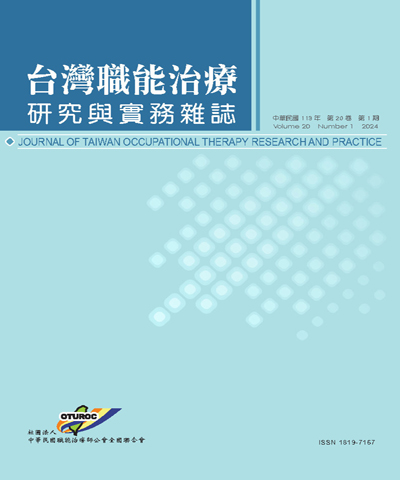
臺灣職能治療研究與實務雜誌/Journal of Taiwan Occupational Therapy Research and Practice
社團法人中華民國職能治療師公會全國聯合會,正常發行
選擇卷期
- 期刊
本研究目的在探討職能治療專業人員所認知的專業角色與功能之現況、期待與建議。藉此拓展專業功能、加強服務內涵與品質,並作為專業教育和繼續教育規劃方向的參考。 研究者由2004年職能治療學會通訊錄中,隨機抽出200人郵寄問卷,共回收67份(33.5%)。個案平均年齡33.6歲(標準差=6.5歲);49位女性(73.1%);服務年資以5~10年(37.3%)及居住於北部者(35.8%)居多。 結果顯示臨床實際狀況與專業理想目標上有落差。期待發揮的功能與服務包括無障礙環境設計、就業安置、輔具義肢選擇、個案管理、環境改造與適應,職業復健與轉銜,與心理輔導,而藥物管理知識須提升。社區化、生活適應與環境改造是專業需發揮的領域,專業教育/繼續教育課程應加以擴展,並加強專業療效之驗證研究。
- 期刊
目的:中風患者常使用代償方法,如使用影響較少的肢體或是軀幹來代償動作缺損,執行功能性活動。代償策略的過度依賴可能阻礙中風後之復原,為矯治中風後的上肢動作缺損,本研究合併軀幹侷限與分散式侷限誘發療法,來限制代償性軀幹動作,促進患側手的功能使用,並探討合併療法較之等治療量的傳統復健,是否帶來較佳之上肢動作與軀幹動作表現。方法:本研究募集14位慢性中風患者,隨機分派至合併療法組以及控制組,接受3週、每週5天、每天2小時之治療,以運動學分析以及渥夫動作功能測驗、動作活動日誌比較兩組治療之療效。運動學分析包括伸臂抓握位於125%手臂長之物體,肢段間協調度、軀幹代償度、以及關節活動度。結果:合併療法組在肩部前屈與手肘伸直之相關性、軀幹前屈與肩前屈之相關性、軀幹代償程度較控制組明顯的改善,其效應值達中至高度。臨床評估上,合併療法組在渥夫動作功能測驗平均品質分數、動作活動日誌優於控制組,呈現接近高度或高度效應。結論:相較於控制組,合併療法改善了中風患者上肢肢段間協調性,減少軀幹代償性動作,提升患肢使用量和使用品質。此研究顯示合併療法後,個案較能採行趨於正常上肢動作模式的控制策略。
- 期刊
目的:漸進式阻力運動是臨床上針對中風病人常見的一個復健治療方法,它有標準的介入準則。本篇目的在分析歸納漸進式阻力運動療效之實證研究,以供臨床及未來研究之參考。方法:經由PubMed、Medline及Scopus等文獻搜尋引擎,搜尋從2000年至2009年間,以關鍵字為:(strength training or resistive exercise) and (stroke or cerebrovascular accident),篩選條件為以漸進式阻力運動為介入方式的文章,最後共選出10篇符合之文獻。結果:漸進式阻力運動對絕大多數訓練肌肉有增加其力量之效果,尤其對輕度中風病人效果較佳,且訓練成果並無呈現出增加肌肉張力現象之證據;對於身體功能、日常生活及活動參與的療效,不同文章有不一樣的結果,須多考慮其他因子,例如在慢性病人身上,漸進式阻力運動也可增加其功能表現及生活品質。結論:漸進式阻力訓練並沒有明顯增加肌肉張力的情況。它可以增加肌肉力量,甚至可能促使身體功能表現進步、日常生活功能及日常生活參與的改進。漸進式阻力訓練對於慢性輕度的病患較有療效,且8週的訓練即已足夠。未來在提供此種訓練時,亦可合併功能導向的訓練,以達病人康復之最大效果。本文的部份結果僅有少數文獻支持,未來仍須進一步的實證研究來驗證其效益。
- 期刊
個案獨立或依賴程度為目前老人健康照護服務的重要考量,也是醫療、社會資源分配的重要指標,然而少有研究有系統的探討獨立或依賴的意涵,中文文獻更是付之闕如,本文回顧相關英文文獻,以歷史觀與醫學、社會、心理、文化與職能治療等觀點,有系統的探討獨立/依賴的意涵,凸顯職能治療專業人員面臨的臨床實務與理論的差異。 以歷史觀而言,職能治療的治療重心從以有目的的活動為治療重心到重視個人自我照顧能力,反映出專業因應社會文化演變與專業發展的需要。近年社會、心理、與文化學學者提出醫療環境所強調的功能性獨立/依賴為一充滿價值觀、多層次、有主觀與客觀面向的概念、是個人與社會文化情境與環境互動的產物。職能治療理論整合近年來的相關理論,對獨立/依賴的新闡釋與所提倡的職能參與為職能治療主要範疇的理念也有同樣特質。然而此理解與目前生物醫學意識型態主導、視獨立/依賴為可客觀測量量化的個人單面屬性的論述互相衝突,職能治療專業人員因此需要在理論與實務的差異中調適。 隨著社會醫療資源分配與失能者的人權議題日益受到關注,身為一重要指標的獨立/依賴相關課題也日益重要。然而如何在實務層次融入獨立/依賴的多面向概念這重要課題仍缺乏明確的實證架構,發展職能參與的評估工具,進而驗證奠基於職能參與理念的治療療效可以幫助縮小理論與實務的差異。
- 期刊
Objective: Handwashing is proven to prevent the infections of diseases such as the entrovirus, SARS, and H1N1 influenza. Whether patients with chronic schizophrenia, often presenting limited perceptual-motor and cognitive function, can correctly implement the correct handwashing procedures and actions is a problem yet to be explored. The purpose of this study is to investigate the handwashing hygiene behavior in patients with chronic schizophrenia in order to facilitate hygiene behavior training. Methods: This study used observation assessment methods, the study subjects are 171 patients in a psychiatric sanatorium in southern Taiwan. With reference to the five steps of handwashing developed by Centers for Disease Control, ROC (Taiwan), a ”Correct Handwashing Score Sheet” was designed and used in the study. Results: At present patients with chronic schizophrenia were only able to perform the hand washing steps (rubbing palm to palm fingers interlaced, rotational rubbing of thumb, rubbing fingertips on the palm, rotational rubbing of wrist, and cupping hands under water to rinse tap three times) at a below average level; the overall functional status of the subjects showed significant differences in the performance of correct hand washing (F=59.30, p<.001); female and male subjects showed no significant difference in the performance of correct handwashing (F=.068, p=.317); different age groups showed significant differences in the performance of correct handwashing (F=4.03, p=.019); different educational levels of subjects showed significant differences in the performance of correct handwashing (F=5.72, p=.001); different disability levels of subjects showed significant differences in the performance of correct handwashing (F=10.71, p=.000). Furthermore, results from multiple regression analysis revealed that predictive variables for correct handwashing performance in patients with mental illness are: nursing floor, and autonomy floor, these two variables could explain 45.0 % of the total variance of proper handwashing performance. Among them, the nursing floor, was shown to be the main predicting variable. Conclusion: Poor overall function of chronic patients with mental illness showed relatively low scores in handwashing performance, thus presenting need to spend more time or adjust teaching methods during future handwashing training. In particular, the actions rubbing hands and cupping hands under water requires repeated instruction, reminders and assistance to implement proper handwashing. It is suggested that future research may explore the cognitive function of chronic patients with mental illness in conjunction with handwashing hygiene training courses, to clarify the learning effects of the patients in actions rubbing hands and cupping hands under water.
- 期刊
Objective: The purpose of the study was to investigate the habits of college students while using their computer workstations in order to prevent future work-related injuries. Methods: 200 college students were recruited from four universities. Because there was no standardized tool to measure the habits and usage of the students' computer workstations, the researchers used a self-made questionnaire to investigate the usage of workstations and working habits of students'. Results: 58.1% of the college students have a correct but basic understanding of the computer workstation. The most commonly reported types of pain among the participants related to computer use included: neck (85.8%), shoulder (83.2%), and back (83.2%). The Chi-square analysis found that pain in forearm (χ^2 (2)=9.11, p<0.05) and back (χ^2 (2)=7.451, p<0.05) occurred significantly more frequently among participants who spent more time using computers. In addition, there were more female college students (85%) who complained about shoulder discomfort than males (75%). Conclusion: 58.1% of the college students have a correct understanding of the computer workstation. These participants were more aware that they should choose ergonomically-designed products for their workstation and develop correct habits of using computers to avoid the musculoskeletal discomfort.

